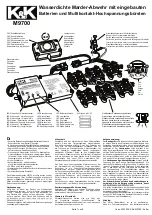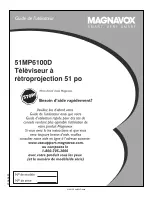
GE Multilin
N60 Network Stability and Synchrophasor Measurement System
2-1
2 PRODUCT DESCRIPTION
2.1 INTRODUCTION
2
2 PRODUCT DESCRIPTION 2.1INTRODUCTION
2.1.1 OVERVIEW
The N60 Network Stability and Synchrophasor Measurement System is a flexible microprocessor-based device intended
for development of load shedding and special protection schemes.
Owing to its modular architecture, the N60 can be configured to monitor from one through five three-phase power circuits.
The relay provides for variety of metering functions, including: active, reactive and apparent power on a per-phase and
three-phase basis; true RMS value, phasors and symmetrical components of currents and voltages; and power factor and
frequency. The latter could be measured independently and simultaneously from up to six different signals.
The N60 allows interfacing other analog signals via optional transducer modules to monitor equipment temperature, trans-
former tap positions, weather data, and other information.
In addition to a standard collection of communications protocols that can be exercised simultaneously and independently
over a range of communication ports, including the redundant Ethernet port, the relay supports an independent mechanism
for direct, fast and secure digital inter-IED communications. This allows both reducing wiring and development time for all
the local connections in a substation, as well as building wide-area protection and control schemes.
Up to 64 on/off signals can be exchanged between any two N60 devices via digital communications. The relays could be
configured in rings with up to 16 devices each using direct fiber (C37.94), G.704 and RS422 interfaces. An optional redun-
dant (dual-channel) communication card supports combinations of the three interfaces allowing different physical connec-
tions in each channel. Dual-ring communication architecture could be selected for redundancy. Open ring or crossover
configurations could be utilized to increase the number of devices in the scheme.
The effective message delivery time depends of number of other N60 devices located between the sending and receiving
IEDs. A two-cycle or one-cycle worst-case message delivery times could be comfortably achieved for comparatively large
N60 schemes.
Sophisticated self-monitoring and diagnostic functions are incorporated such as the 32-bit CRC, unreturned messages
count or lost packets counts. The N60 supports both multiplexed and direct fiber (up to 100 km) inter-substation connec-
tions.
The N60 allows sending and receiving any analog value measured by the relay using the dedicated inter-IED communica-
tion mechanisms. Power, voltage and current magnitudes, frequency, transducer inputs and other values can be freely con-
figured for the inter-IED exchanges. The analog values are transmitted with the eight-bit resolution. Upon reception, any
remote analog value could be re-sent, compared with another value or a constant threshold, added to or subtracted from
other local or remote analog value, subjected to the rate-of-change monitoring, etc. This powerful feature allows advanced
applications such as balancing power over wide areas, or adding extra security by comparing local and remote measure-
ments for consistency. It also facilitates simple telemetry.
Diagnostic features include an event recorder capable of storing 1024 time-tagged events, oscillography capable of storing
up to 64 records with programmable trigger, content and sampling rate, and data logger acquisition of up to 16 channels,
with programmable content and sampling rate. The internal clock used for time-tagging can be synchronized with an IRIG-
B signal or via the SNTP protocol over the Ethernet port. This precise time stamping allows the sequence of events to be
determined throughout the system. Events can also be programmed (via FlexLogic™ equations) to trigger oscillography
data capture which may be set to record the measured parameters before and after the event for viewing on a personal
computer (PC). These tools significantly reduce troubleshooting time and simplify report generation in the event of a sys-
tem fault.
A faceplate RS232 port may be used to connect to a PC for the programming of settings and the monitoring of actual val-
ues. A variety of communications modules are available. Two rear RS485 ports allow independent access by operating and
engineering staff. All serial ports use the Modbus
®
RTU protocol. The RS485 ports may be connected to system computers
with baud rates up to 115.2 kbps. The RS232 port has a fixed baud rate of 19.2 kbps. Optional communications modules
include a 10BaseF Ethernet interface which can be used to provide fast, reliable communications in noisy environments.
Another option provides two 10BaseF fiber optic ports for redundancy. The Ethernet port supports MMS/UCA2, Modbus
®
/
TCP, and TFTP protocols, and allows access to the relay via any standard web browser (UR web pages). The IEC 60870-
5-104 protocol is supported on the Ethernet port. DNP 3.0 and IEC 60870-5-104 cannot be enabled at the same time.
The N60 IEDs use flash memory technology which allows field upgrading as new features are added. The following Single
Line Diagram illustrates the relay functionality using ANSI (American National Standards Institute) device numbers.










































